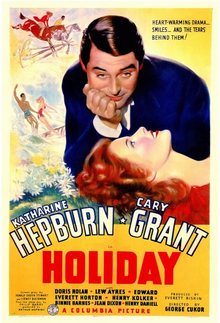
George Dewey Cukor was an American film director and producer. He mainly concentrated on comedies and literary adaptations. His career flourished at RKO when David O. Selznick, the studio's Head of Production, assigned Cukor to direct several of RKO's major films, including What Price Hollywood? (1932), A Bill of Divorcement (1932), Our Betters (1933), and Little Women (1933). When Selznick moved to Metro-Goldwyn-Mayer in 1933, Cukor followed and directed Dinner at Eight (1933) and David Copperfield (1935) for Selznick, and Romeo and Juliet (1936) and Camille (1936) for Irving Thalberg.

Screwball comedy is a film subgenre of the romantic comedy genre that became popular during the Great Depression, beginning in the early 1930s and thriving until the early 1950s, that satirizes the traditional love story. It has secondary characteristics similar to film noir, distinguished by a female character who dominates the relationship with the male central character, whose masculinity is challenged, and the two engage in a humorous battle of the sexes.

Katharine Houghton Hepburn was an American actress whose career as a Hollywood leading lady spanned six decades. She was known for her headstrong independence, spirited personality, and outspokenness, cultivating a screen persona that matched this public image, and regularly playing strong-willed, sophisticated women. Her work was in a range of genres, from screwball comedy to literary drama, and earned her various accolades, including four Academy Awards for Best Actress—a record for any performer. In 1999, Hepburn was named the greatest female star of classic Hollywood cinema by the American Film Institute.
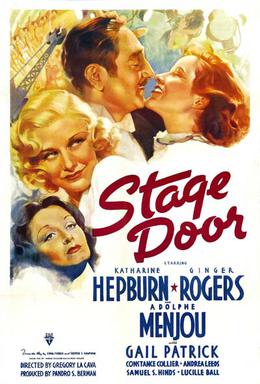
Stage Door is a 1937 American drama film directed by Gregory La Cava. Adapted from the play of the same name, it tells the story of several would-be actresses who live together in a boarding house at 158 West 58th Street in New York City. The film stars Katharine Hepburn, Ginger Rogers, Adolphe Menjou, Gail Patrick, Constance Collier, Andrea Leeds, Samuel S. Hinds and Lucille Ball. It was produced and distributed by RKO Pictures. Eve Arden and Ann Miller, who became notable in later films, play minor characters.
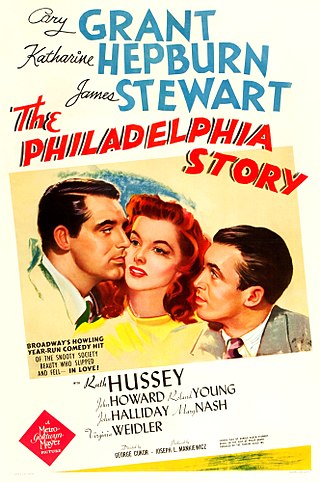
The Philadelphia Story is a 1940 American romantic comedy film directed by George Cukor, starring Cary Grant, Katharine Hepburn, James Stewart, and Ruth Hussey. Based on the 1939 Broadway play of the same name by Philip Barry, the film is about a socialite whose wedding plans are complicated by the simultaneous arrival of her ex-husband and a tabloid magazine journalist. The socialite character of the play—performed by Hepburn in the film—was inspired by Helen Hope Montgomery Scott (1904–1995), a Philadelphia socialite known for her hijinks, who married a friend of playwright Barry.

Bringing Up Baby is a 1938 American screwball comedy film directed by Howard Hawks, and starring Katharine Hepburn and Cary Grant. It was released by RKO Radio Pictures. The film tells the story of a paleontologist in a number of predicaments involving a scatterbrained heiress and a leopard named Baby. The screenplay was adapted by Dudley Nichols and Hagar Wilde from a short story by Wilde which originally appeared in Collier's Weekly magazine on April 10, 1937.

Holiday is a 1930 American pre-Code romantic comedy film which tells the story of a young man who is torn between his free-thinking lifestyle and the tradition of his wealthy fiancée's family. It stars Ann Harding, Mary Astor, Edward Everett Horton, Robert Ames and Hedda Hopper. It was produced and released by Pathé Exchange.

A Bill of Divorcement is a 1932 American pre-Code drama film directed by George Cukor and starring John Barrymore and Katharine Hepburn in her film debut. It is based on the 1921 British play of the same name, written by Clemence Dane as a reaction to a law passed in Britain in the early 1920s that allowed insanity as grounds for a woman to divorce her husband. It was the second screen adaptation of the play; the first was a 1922 British silent film also titled A Bill of Divorcement. The film was made again in 1940 by RKO Pictures.

Sylvia Scarlett is a 1935 American romantic comedy film starring Katharine Hepburn and Cary Grant, based on The Early Life and Adventures of Sylvia Scarlett, a 1918 novel by Compton MacKenzie. Directed by George Cukor, it was notorious as one of the most famous unsuccessful movies of the 1930s. Hepburn plays the title role of Sylvia Scarlett, a female con artist masquerading as a boy to escape the police. The success of the subterfuge is in large part due to the transformation of Hepburn by RKO makeup artist Mel Berns.

Little Women is a 1933 American pre-Code drama film directed by George Cukor, and starring Katharine Hepburn, Joan Bennett, Frances Dee, and Jean Parker. The screenplay, written by Sarah Y. Mason and Victor Heerman, is based on the 1868-1869 two-volume novel of the same name by Louisa May Alcott.
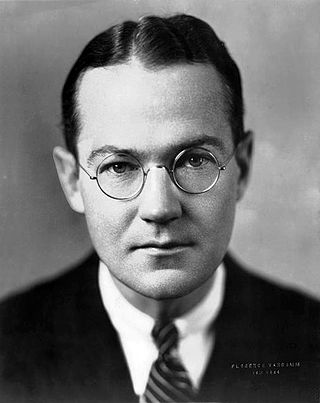
Philip Jerome Quinn Barry was an American dramatist best known for his plays Holiday (1928) and The Philadelphia Story (1939), which were both made into films starring Katharine Hepburn and Cary Grant.

Keeper of the Flame is a 1942 American drama film directed by George Cukor, and starring Spencer Tracy and Katharine Hepburn, released by Metro-Goldwyn-Mayer (MGM). The screenplay by Donald Ogden Stewart is adapted from the 1942 novel Keeper of the Flame by I. A. R. Wylie. Hepburn plays the widow of a famous civic leader who has died in an accident. Tracy portrays a former war correspondent who intends to write a flattering biography of the dead man, only to find that his death is shrouded in mystery. Screenwriter Stewart considered the script the finest moment of his career, feeling vindicated by the assignment as he believed that Hollywood had punished him for years for his political views. Principal filming began in the last week of August 1942, four months after the release of the novel, published by Random House. The picture was filmed on a sound stage, with no location shooting. Hepburn had already begun a relationship with Tracy, and his heavy drinking led her to become his vigilant guardian during the filming.
The comedy of remarriage is a subgenre of American comedy films of the 1930s and 1940s. At the time, the Production Code, also known as the Hays Code, banned any explicit references to or attempts to justify adultery and illicit sex. The comedy of remarriage with the same spouse enabled filmmakers to evade this provision of the Code. The protagonists divorced, flirted with strangers without risking the wrath of censorship, and then got back together.

In Name Only is a 1939 romantic film starring Cary Grant, Carole Lombard, and Kay Francis, directed by John Cromwell. It was based on the 1935 novel Memory of Love by Bessie Breuer. The fictional town where it is set, Bridgefield, Connecticut, is based on the town of Ridgefield, Connecticut.
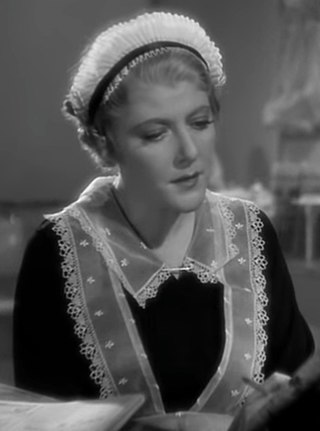
Jean Dixon was an American stage and film actress.

Alice Adams is a 1935 romantic drama film directed by George Stevens and starring Katharine Hepburn. It was made by RKO and produced by Pandro S. Berman. The screenplay was by Dorothy Yost, Mortimer Offner, and Jane Murfin. The film was adapted from the novel Alice Adams by Booth Tarkington. The music score was by Max Steiner and Roy Webb, and the cinematography by Robert De Grasse. The film received Academy Award nominations for Best Picture and Best Actress.
Happy New Year is a musical with a book by Burt Shevelove and music and lyrics by Cole Porter.

Without Love is a 1945 romantic comedy film directed by Harold S. Bucquet and starring Spencer Tracy, Katharine Hepburn, and Lucille Ball. Based on a 1942 play by Philip Barry, the film's screenplay was written by Donald Ogden Stewart.

Holiday is a 1928 play by Philip Barry which was twice adapted to film. The original play opened in New York on November 26, 1928, at the Plymouth Theatre and closed in June 1929, after 229 performances. It was directed by Arthur Hopkins, set design by Robert Edmond Jones, and costume design by Margaret Pemberton.

Katharine Martha Houghton Hepburn was an American feminist social reformer and a leader of the suffrage movement in the United States. Hepburn served as president of the Connecticut Woman Suffrage Association before joining the National Woman's Party. In 1923 Hepburn formed the Connecticut Branch of the American Birth Control League with two of her friends, Mrs. George Day and Mrs. M. Toscan Bennett. She was the mother and namesake of actress Katharine Hepburn and the grandmother and namesake of actress Katharine Houghton.
